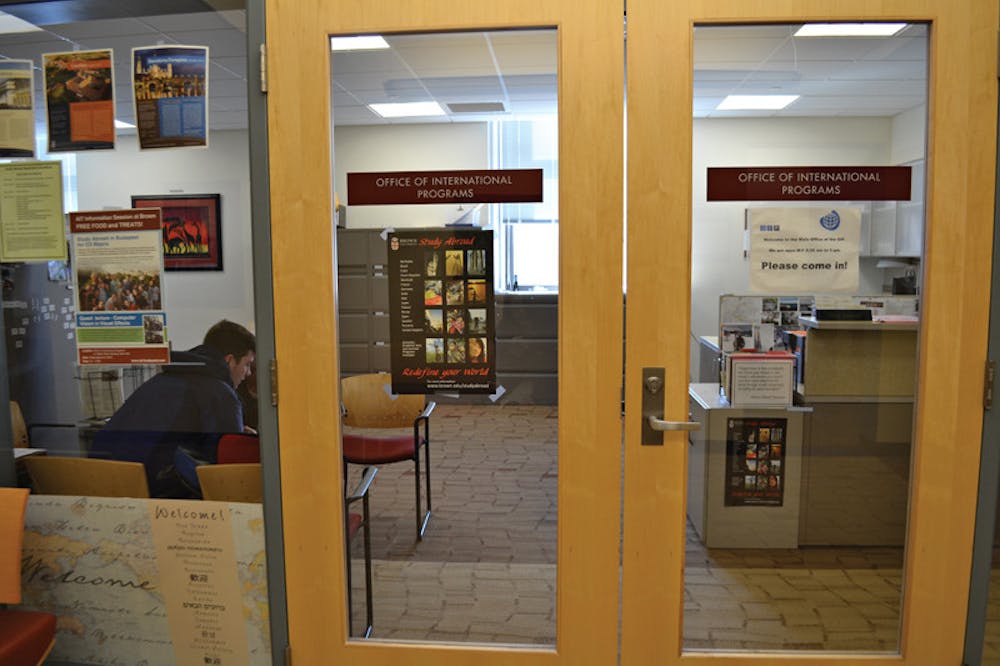The number of students studying abroad this semester has spiked 27 percent from last fall amid an improving economy and continued interest in overseas study programs, administrators said.
Two hundred eighty-one students are enrolled in study abroad programs this semester, an increase from 206 participating students last fall and a 32 percent jump from the 190 students who studied abroad last semester, according to data from the Office of International Programs.
Kendall Brostuen, associate dean and director of international programs, attributed the increase in study abroad participants to the economic recovery in the United States. Study abroad enrollment figures have jumped at colleges and universities across the country, Brostuen wrote in an email to The Herald.
Brown students have a “growing sense on campus of the value and importance of incorporating an international dimension to one’s four-year Brown experience,” Brostuen said. The number of students studying abroad this semester is the highest total for any semester over the past five years, according to OIP data.
Brostuen said he projects 180 to 190 students will study abroad next semester, around the same number of students who went abroad last spring. Though deadlines for spring study abroad programs have passed, the number of students studying abroad this spring may still increase, as the OIP accepts late applications, Brostuen said.
The number of students completing a full year abroad — 33 — is the highest total since the 2010-2011 academic year, according to OIP data.
Western Europe continues to be the most popular destination for students studying abroad, according to OIP data. Nearly two-thirds of students who went abroad last year studied in Western Europe, while about 11 percent of students went to Latin America and the Caribbean. Asia accounted for 6 percent, as did the Middle East and North Africa, while sub-Saharan Africa accounted for about 4 percent, Oceania accounted for less than 3 percent and Eastern Europe accounted for 2 percent. Two percent of students completed study abroad programs in more than one country, according to OIP data.
The United Kingdom is the most common destination for Brown students studying abroad this semester, followed, in order, by Spain, France and Italy, Brostuen said. He added that these countries have consistently been the most popular study abroad destinations in recent years.
Peter Asimov ’14, who studied in France last year, said the application process was “seamless,” adding that “procedures are pretty straightforward” for transferring credit back to the University.
Other students said the OIP provides effective assistance to those hoping to study abroad but that the process of transferring credits can present challenges in certain academic departments.
Peter Kentros ’14, who completed a full year at Oxford University last year, said “the people working in the OIP were very helpful.” But Kentros expressed frustration that some departments do not pre-approve courses for credit before a student goes abroad, which can complicate the completion of concentration requirements.
John Rady ’14, who also studied for a full year at Oxford, agreed that the process of transferring credits presents challenges. “I’m having trouble getting credit for my courses now,” Rady said. “It has been a lot more labor-intensive than I expected it to be.”
Recent political turmoil in the Middle East has caused a spike in the number of study abroad programs on the OIP’s Travel Prohibition List, the list of countries in which students cannot gain transferable credits, Brostuen said. The Travel Prohibition List follows guidelines for restricted travel released by the U.S. Department of State, Brostuen said. But State Department guidelines are not all-inclusive, Brostuen said, adding that administrators can place other programs on the OIP’s list of restricted programs.
Though regional turmoil has increased the number of Middle East programs placed on the Travel Prohibition List, the OIP still offers multiple programs in Israel, according to OIP data. The previously approved study abroad program in Egypt remains suspended this fall, The Herald previously reported.
The OIP continues to promote increased enrollment in the Brown Plus One initiatives, which allow students to receive a master’s degree in five years if they complete a semester abroad at one of the program’s affiliated institutions as undergraduates and then return for another year after graduating from Brown, Brostuen said. Chinese University in Hong Kong, Pompeu Fabra University in Barcelona, Trinity College Dublin and the University of Edinburgh currently partner with the University in offering Brown Plus One programs.

ADVERTISEMENT




